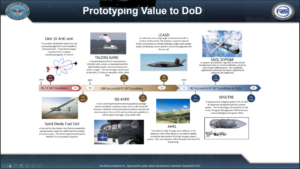
Accelerating electronic warfare (EW) dominance, nuclear modernization, hypersonics, the development of fully networked command, control, and communications (FNC3), and test and evaluation infrastructure are the top priorities in fiscal 2021 for James Faist, the director of Defense Research and Engineering for Advanced Capabilities (DDR&E AC).
While the specific EW dominance work is classified, DDR&E AC is focusing on EW as “a many-on-many offensive capability viable in highly contested environments,” Faist said during a June 22 National Defense Industrial Association (NDIA) webinar.
In fiscal 2021, DDR&E AC plans to weave into its EW dominance effort related work on artificial intelligence, autonomy, cyber systems, fully networked C3, and quantum capabilities for resilient Positioning, Navigation and Timing (PNT)–much of it reliant on Global Positioning System satellites.
On hypersonics, Faist said that DDR&E AC has established a Joint Hypersonics Transition Office (JHTO) with $100 million in funding. Congressional appropriators funded the office “to develop and implement an integrated science and technology roadmap for hypersonics and to establish a university consortium for hypersonics research and workforce development.”
JHTO wants to reduce risk on the development of a hypersonic cruise missile engine and is collaborating with the Australia Hypersonic Working Group and the United Kingdom, which may consider a hypersonic power plant for its sixth generation fighter under Project Tempest.
The United States Army said last June that it plans to field a hypersonic weapon in fiscal 2023.
During the June 22 NDIA webinar, Timothy Dare, DDR&E AC’s deputy director for prototyping and engineering and the director of developmental test, evaluation and prototyping (DTEP), said that his office has received 1,320 submissions in response to a global needs statement seeking novel DoD capabilities for use against a near-peer competitor and an operational prototype by 2028. The global needs statement includes 11 priority areas: artificial intelligence/machine learning, autonomy, biotechnology, cyber, directed energy, FNC3, hypersonics, microelectronics, quantum, space, and 5G.
“We received many inputs, which we’re going through right now,” Dare said.
Of the 1,320 submissions, the most–327–were in the area of AI/machine learning, followed by space–137, autonomy–119, cyber–113, emerging disruptive technologies and capabilities–109, FNC3–74, biotechnology–60, and hypersonics–48.
Dare’s office is to choose 30 or so submissions by June 29 and hear briefings from the selected firms in September.
Last year, $488 million for Pentagon DTEP and another $133 million from the military services went toward 122 prototyping efforts. Dare said that some 80 percent of the prototypes transition to follow-on efforts, including programs of record.